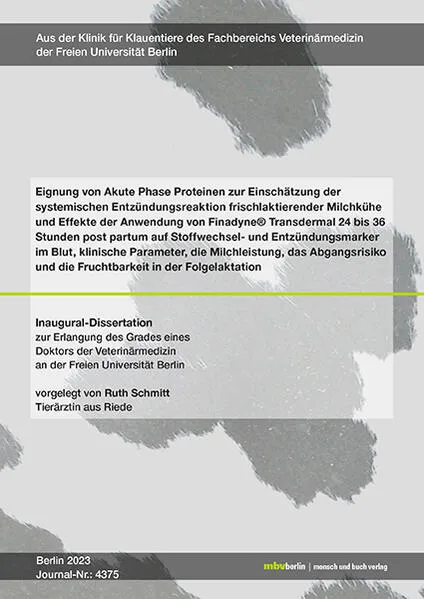
Ruth Schmitt
Eignung von Akute Phase Proteinen zur Einschätzung der systemischen Entzündungsreaktion frischlaktierender Milchkühe und Effekte der Anwendung von Finadyne® Transdermal 24 bis 36 Stunden post partum auf Stoffwechsel- und Entzündungsmarker im Blut,
- klinische Parameter, die Milchleistung, das Abgangsrisiko und die Fruchtbarkeit in der Folgelaktation
ISBN: 978-3-967-29204-6
202 Seiten | € 49.90
Buch [Taschenbuch]
Erscheinungsdatum:
10.07.2023
Sonstiges
Ruth Schmitt
Eignung von Akute Phase Proteinen zur Einschätzung der systemischen Entzündungsreaktion frischlaktierender Milchkühe und Effekte der Anwendung von Finadyne® Transdermal 24 bis 36 Stunden post partum auf Stoffwechsel- und Entzündungsmarker im Blut,
klinische Parameter, die Milchleistung, das Abgangsrisiko und die Fruchtbarkeit in der Folgelaktation
Diagnostic value of Acute Phas e Proteins for evaluating systemic inflammation in fresh lactating dairy cows and effects of a single transdermal administration of Finadyne® Transdermal within 24 to 36 hours postpartum on inflammatory and metabolic markers in blood, clinical parameters, milk yield, culling risk and fertility in subsequent lactation
Systemic inflammation is nowadays considered a key element of various transition diseases in high yielding dairy cows. While a certain degree of inflammation around calving represents a physiological defense mechanism of the innate immune system to calving-associated stressors (acute-phase reaction), excessive inflammation impairs metabolism and immunity, thereby leading to reduced productivity in subsequent lactation. A primary objective of the preliminary trial reported inhere was to identify a suitable acute-phase protein for the detection of both individual cows (cow level) and herds (group level) with systemic inflammation within the first week after calving. Therefore, serum concentrations of different acute-phase proteins (haptoglobin, serum-amyloid-A, total protein, albumin, coeruloplasmin, and C-reactive protein) were measured in 99 individual and 10 pooled serum-, lithium-heparinized-, and EDTA-plasma samples, respectively, from 10 farms. Further, haptoglobin concentrations were determined in serum, lithium-heparinized and EDTA-plasma samples using a chemical autoanalyzer and an ELISA-test kit, respectively, to derive recommendations for the most suitable sample type and measurement method, respectively. In the main trial, the effects of a single transdermal administration of flunixin meglumine (Finadyne® transdermal) within 24 – 36 hours postpartum on laboratory metabolic and inflammatory markers, health, milk yield and fertility of 500 dairy cows were investigated in a randomized, prospective clinical trial.
Haptoglobin significantly differentiated farms and correlated most closely with both the cows’ rectal body temperature and Metricheck™ score. Furthermore, pooled samples correlated well with individual samples, emphasizing the usefulness of haptoglobin as inflammatory marker in the periparturient period for both individuals and herds. Serum should be the preferred sample type for haptoglobin measurement, since both types of plasma seem to deliver false high values with higher variation. Measurements with the chemical autoanalyzer were more precise compared to the ELISA-test kit, which was attributable to dilutions performed prior to the ELISA-assay. Based on the results of the preliminary trial, three farms with cows at risk for excessive systemic inflammation were chosen to participate in the main trial.
Primiparous cows treated with Finadyne® Transdermal had lower serum haptoglobin and higher serum albumin concentrations compared to cows that remained untreated. Treated multiparous cows had slightly lower serum betahydroxybutyrate concentrations compared with control cows. Metritis risk was lower in treated primiparous cows compared to control cows, whereas no difference was observed in multiparous cows. Regardless of parity, treated cows had lower odds of showing symptoms of pain (arched back or altered tail position) on the day after treatment compared to cows receiving the placebo. Energy corrected milk yield from 8 monthly milk recordings was on average 0,87 ± 1,35 kg higher in treated primiparous cows compared to control. Treated multiparous cows yielded on average 0,76 ± 1,17 kg less compared to the placebo group. 305 day milk yield tended to be 399 ± 430 kg higher in treated primiparous cows and 224 ± 313 kg lower in treated multiparous cows compared to their respective control group. No differences in culling risk, first-service conception risk, time to conception and risk of pregnancy within 200 days in milk were observed.
The results from both trials presented herein emphasize the impact of systemic inflammation during the transition period on subsequent health and performance of dairy cows. A comfortable transition pen providing enough space for feeding and resting, adequate diet, wellorganized calving management, optimized hygiene and body condition should still be considered the primary key to preventing excessive postpartum inflammation and solving herd health issues in the transition period. Especially heifers seem to be more susceptible to systemic inflammation around parturition. This might be attributable to a relatively high level of social stress at first calving, a higher incidence of calving difficulties, vulvo-vaginal lesions, and metritis. Herd management should therefore focus on optimizing comfort for primiparous cows during the transition period. Based on the results of the present study, additional treatment of early postpartum primiparous cows with an NSAID (e.g., Finadyne® Transdermal) can be beneficial. This is not recommended for multiparous cows. Future research in this field should focus on comparing the effects of Finadyne® Transdermal treatment during the early postpartum period using other timings and dosing regimens (e.g., multiple applications).
Systemic inflammation is nowadays considered a key element of various transition diseases in high yielding dairy cows. While a certain degree of inflammation around calving represents a physiological defense mechanism of the innate immune system to calving-associated stressors (acute-phase reaction), excessive inflammation impairs metabolism and immunity, thereby leading to reduced productivity in subsequent lactation. A primary objective of the preliminary trial reported inhere was to identify a suitable acute-phase protein for the detection of both individual cows (cow level) and herds (group level) with systemic inflammation within the first week after calving. Therefore, serum concentrations of different acute-phase proteins (haptoglobin, serum-amyloid-A, total protein, albumin, coeruloplasmin, and C-reactive protein) were measured in 99 individual and 10 pooled serum-, lithium-heparinized-, and EDTA-plasma samples, respectively, from 10 farms. Further, haptoglobin concentrations were determined in serum, lithium-heparinized and EDTA-plasma samples using a chemical autoanalyzer and an ELISA-test kit, respectively, to derive recommendations for the most suitable sample type and measurement method, respectively. In the main trial, the effects of a single transdermal administration of flunixin meglumine (Finadyne® transdermal) within 24 – 36 hours postpartum on laboratory metabolic and inflammatory markers, health, milk yield and fertility of 500 dairy cows were investigated in a randomized, prospective clinical trial.
Haptoglobin significantly differentiated farms and correlated most closely with both the cows’ rectal body temperature and Metricheck™ score. Furthermore, pooled samples correlated well with individual samples, emphasizing the usefulness of haptoglobin as inflammatory marker in the periparturient period for both individuals and herds. Serum should be the preferred sample type for haptoglobin measurement, since both types of plasma seem to deliver false high values with higher variation. Measurements with the chemical autoanalyzer were more precise compared to the ELISA-test kit, which was attributable to dilutions performed prior to the ELISA-assay. Based on the results of the preliminary trial, three farms with cows at risk for excessive systemic inflammation were chosen to participate in the main trial.
Primiparous cows treated with Finadyne® Transdermal had lower serum haptoglobin and higher serum albumin concentrations compared to cows that remained untreated. Treated multiparous cows had slightly lower serum betahydroxybutyrate concentrations compared with control cows. Metritis risk was lower in treated primiparous cows compared to control cows, whereas no difference was observed in multiparous cows. Regardless of parity, treated cows had lower odds of showing symptoms of pain (arched back or altered tail position) on the day after treatment compared to cows receiving the placebo. Energy corrected milk yield from 8 monthly milk recordings was on average 0,87 ± 1,35 kg higher in treated primiparous cows compared to control. Treated multiparous cows yielded on average 0,76 ± 1,17 kg less compared to the placebo group. 305 day milk yield tended to be 399 ± 430 kg higher in treated primiparous cows and 224 ± 313 kg lower in treated multiparous cows compared to their respective control group. No differences in culling risk, first-service conception risk, time to conception and risk of pregnancy within 200 days in milk were observed.
The results from both trials presented herein emphasize the impact of systemic inflammation during the transition period on subsequent health and performance of dairy cows. A comfortable transition pen providing enough space for feeding and resting, adequate diet, wellorganized calving management, optimized hygiene and body condition should still be considered the primary key to preventing excessive postpartum inflammation and solving herd health issues in the transition period. Especially heifers seem to be more susceptible to systemic inflammation around parturition. This might be attributable to a relatively high level of social stress at first calving, a higher incidence of calving difficulties, vulvo-vaginal lesions, and metritis. Herd management should therefore focus on optimizing comfort for primiparous cows during the transition period. Based on the results of the present study, additional treatment of early postpartum primiparous cows with an NSAID (e.g., Finadyne® Transdermal) can be beneficial. This is not recommended for multiparous cows. Future research in this field should focus on comparing the effects of Finadyne® Transdermal treatment during the early postpartum period using other timings and dosing regimens (e.g., multiple applications).
Unterstütze den lokalen Buchhandel
Nutze die PLZ-Suche um einen Buchhändler in Deiner Nähe zu finden.
Bestelle dieses Buch im Internet
| Veröffentlichung: | 10.07.2023 |
| Höhe/Breite/Gewicht | H 21 cm / B 14,8 cm / 420 g |
| Seiten | 202 |
| Art des Mediums | Buch [Taschenbuch] |
| Preis DE | EUR 49.90 |
| Preis AT | EUR 51.30 |
| Auflage | 1. Auflage |
| ISBN-13 | 978-3-967-29204-6 |
| ISBN-10 | 3967292045 |
Diesen Artikel teilen
0 Kommentar zu diesem Buch
Leserunde
Leserunde zu Kiss the Enemy!
Bewerbungsfrist bis zum: 08.10.2024


